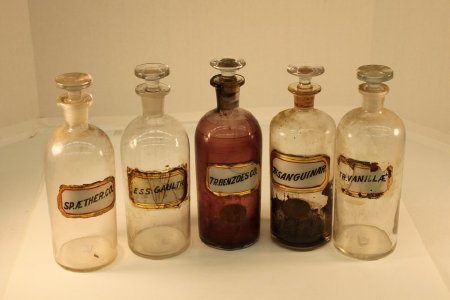Object ID Number:
PH169
Object Name:
Bottles
Type:
Shop Furniture
Date of Manufacture:
/ /
Manufactured from:
1820
Manufactured to:
1850
Description / History:
Collection of five large 19th century, clear glass bottles. Used to store bulk chemicals for dispensing. Each bottle has a white label with gold trim. Labels are affixed to the bottles with a thin sheet of curved glass.
They contain(ed):
Bottle A: This bottle once contained ether. Although discovered in 1275, ether was not used as an anesthetic unti 1841. The spelling of ether on this bottle as "aether" differs from the modern spelling and may lead some to believe this to be a completely different chemical property. However, the "ae" is a Latin derived letter, preserved in several Latin words that entered the English language between the 16th and 19th centuries. Most of these words, such as anaesthesia and aether, now lack the "a" in modern usage.
Bottle B: This bottle once contained an alcoholic solution of vanilla. There are major advantages and disadvantages to using alcoholic solutions of a compound. One advantage is that ethanol can dissolve compounds not soluble in water. However, a major disadvantage is the use of ethanol has the potential to change, or denature, a compound so much as to render it ineffective.
Vanilla was used to treat asthma, congestion, cough, and syphilis. Up until the 20th century, vanilla was dispensed from pharmacies as a way to treat an upset stomach.
Bottle C: This bottle contained tincture of benzion. This solution of benzion was often applied to a patient's skin before the application of bandages or tape. This was done mainly to allow adhesives to last longer, with a secondary intention of preventing allergic reactions in those with allergies to the chosen adhesive. It was also used as hemostatic agent, and as an antiseptic. In modernity, the American Army uses tincture of benzion as an antiseptic.
Bottle D: This bottle contained a tincture of sanguinar, which was used to treat dysmenorrhoea in combination with other medicines. Furthermore, it was also used to treat pneumonia, bronchitis, and to protect mucous linings of the nasal passages.
Bottle E: Contained Gaulth, which was used to cover the taste of iodine. Many patients could not tolerate the taste of iodine alone, and since iodine was soluble with only a few liquids, doctors came up with the idea of mixing molasses, gaulth, and iodine so that patients could tolerate the taste of their medications.
They contain(ed):
Bottle A: This bottle once contained ether. Although discovered in 1275, ether was not used as an anesthetic unti 1841. The spelling of ether on this bottle as "aether" differs from the modern spelling and may lead some to believe this to be a completely different chemical property. However, the "ae" is a Latin derived letter, preserved in several Latin words that entered the English language between the 16th and 19th centuries. Most of these words, such as anaesthesia and aether, now lack the "a" in modern usage.
Bottle B: This bottle once contained an alcoholic solution of vanilla. There are major advantages and disadvantages to using alcoholic solutions of a compound. One advantage is that ethanol can dissolve compounds not soluble in water. However, a major disadvantage is the use of ethanol has the potential to change, or denature, a compound so much as to render it ineffective.
Vanilla was used to treat asthma, congestion, cough, and syphilis. Up until the 20th century, vanilla was dispensed from pharmacies as a way to treat an upset stomach.
Bottle C: This bottle contained tincture of benzion. This solution of benzion was often applied to a patient's skin before the application of bandages or tape. This was done mainly to allow adhesives to last longer, with a secondary intention of preventing allergic reactions in those with allergies to the chosen adhesive. It was also used as hemostatic agent, and as an antiseptic. In modernity, the American Army uses tincture of benzion as an antiseptic.
Bottle D: This bottle contained a tincture of sanguinar, which was used to treat dysmenorrhoea in combination with other medicines. Furthermore, it was also used to treat pneumonia, bronchitis, and to protect mucous linings of the nasal passages.
Bottle E: Contained Gaulth, which was used to cover the taste of iodine. Many patients could not tolerate the taste of iodine alone, and since iodine was soluble with only a few liquids, doctors came up with the idea of mixing molasses, gaulth, and iodine so that patients could tolerate the taste of their medications.
Dimensions:
H–10.25 W–3.25 inches
3D Image Information:
The 3 dimensional image can be viewed using Google Chrome, Safari, or Firefox browsers.
3 Dimentional Image:
